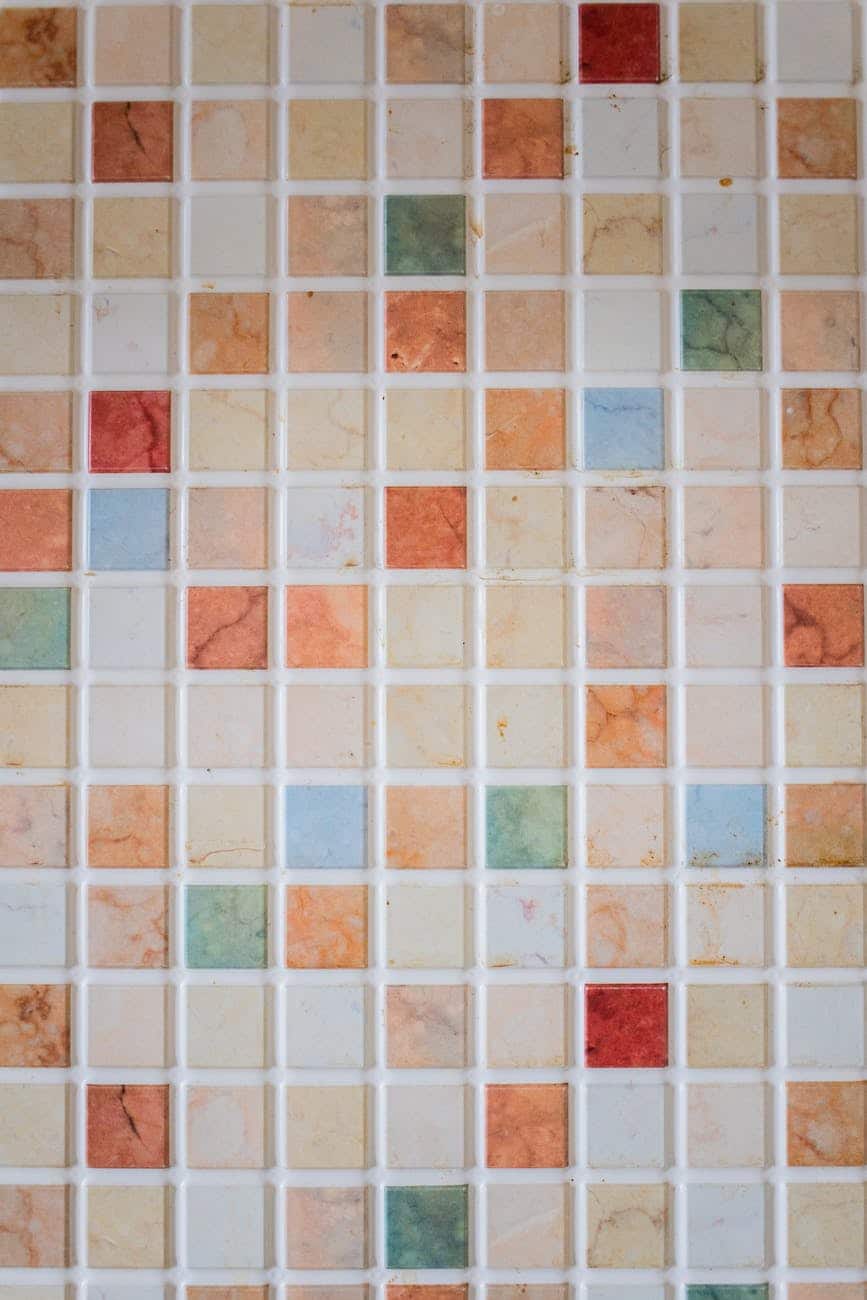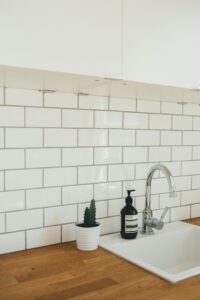The Power of Tiling Patterns
Tiling patterns hold a transformative power that’s often overlooked in home and commercial interior design. Understanding the impact of these patterns and how they can alter the perception of space is critical for anyone seeking to redefine an area using creative tiling solutions.
The Impact of Tiling on Space Perception
The choice of tiling pattern can drastically influence how a room is perceived. For instance, larger tiles with fewer grout lines can make a small space appear bigger, while a busy mosaic pattern can add visual interest and depth to a larger, more impersonal area.
Diagonal patterns, such as the diamond layout, can help elongate a room, creating an illusion of extra space. Vertical tiling patterns, on the other hand, can make low ceilings appear taller. For rooms with high ceilings, horizontal tiling patterns can help bring the scale down, making the space feel more intimate.
Tiling can also impact the room’s lighting. Light-colored tiles reflect more light, making a room feel brighter and more spacious. Dark tiles can create a cozy, intimate atmosphere but may need extra lighting to prevent the room from feeling too closed off.
How to Use Tiling to Change the Look of a Room
Tiling, when used effectively, can completely transform a room’s aesthetics. Experimenting with different patterns, colors, and tile sizes can create unique and custom looks catered to the individual’s style and preference.
For instance, one might consider using geometric patterns to add a modern touch to a living room or a classic subway tile in a brick pattern for a timeless kitchen backdrop.
Combining different tiling patterns in the same room, such as a herringbone pattern on the floor and a straight lay pattern on the walls, can create a visually engaging contrast.
Tiling doesn’t have to be limited to the floor and walls. Decorating a ceiling with tiles can create a dramatic effect, while a tiled fireplace can serve as an eye-catching focal point.
For more insight into how tiling patterns can transform spaces, explore our articles on choosing the right tile for your kitchen: a guide and maximize your space: expert tips for tiling small bathrooms.
In conclusion, tiling patterns have the power to visually alter the size, shape, and overall aesthetic of a room. By understanding the impact of these patterns, one can make informed decisions and use tiling to its full potential. Whether it’s through creating illusions of space, adding depth, or introducing a new design element, transforming spaces with creative tiling patterns opens up a world of design possibilities.
Popular Tiling Patterns and Their Effects
Tiling patterns can dramatically influence the aesthetics and perception of space within a room. Each pattern carries a unique visual appeal and can transform spaces in different ways. Here, we will explore four popular tiling patterns and their effects.
Straight Lay Pattern
A straight lay pattern is the most traditional and common pattern used in tiling. This pattern features tiles laid in straight lines so that the tile edges align to form a grid. It is simple, yet effective, and often used for its clean lines and uncomplicated design.
The straight lay pattern is versatile and can work in any room, regardless of size or style. This pattern can make a room appear larger and is ideal for showcasing beautiful tiles without the pattern being a distraction. For more insights on how tile size and placement can impact a room’s appearance, visit our guide on transforming spaces with creative tiling patterns.
Brick or Offset Pattern
The brick or offset pattern, often referred to as the subway tile pattern, features tiles laid in an offset manner, similar to bricks in a wall. Each row is typically offset by half the width of the tile. This pattern adds visual interest and movement to a space, making it ideal for adding a dynamic element to any room.
The brick pattern can make a narrow room appear wider, making it a popular choice for small bathrooms or narrow kitchen backsplashes. For more tips on tiling smaller spaces, visit our guide on maximize your space: expert tips for tiling small bathrooms.
Herringbone Pattern
The herringbone pattern is a distinctive and sophisticated tiling pattern. It features tiles laid in a V shape, similar to a herringbone’s bones. This pattern adds depth and dimension to a space, making it appear larger and more dynamic.
The herringbone pattern requires more cutting and fitting than simpler patterns, but the striking effect it creates can be well worth the extra effort. It works particularly well in larger spaces where the full pattern can be appreciated. For more advanced tiling techniques, check out our guide on advanced tiling tips for commercial projects.
Basket Weave Pattern
The basket weave pattern is a classic tiling pattern that creates a woven illusion. This pattern alternates between horizontal and vertical pairs of tiles, creating a distinctive and visually appealing effect.
The basket weave pattern is ideal for adding a historic or traditional feel to a space. It works well in bathrooms, kitchens, or hallways, adding depth and interest to these spaces. For more creative tiling solutions for different rooms, visit our guide on innovative tiling solutions for challenging spaces.
Understanding the effects of different tiling patterns can help you make the best choice for your space and design aesthetic. For more insights on tiling patterns and how they can transform your space, visit our in-depth guide to tiling.
Creative Tiling Patterns for Specific Rooms
Using creative tiling patterns can significantly transform the aesthetics and perception of various rooms in a house. Whether it’s the kitchen, bathroom, or living room, the right tiling pattern can add an element of sophistication and style.
Transforming a Kitchen with Tiling
The kitchen is the heart of the home, and an innovative tiling pattern can enhance its appeal. For instance, a straight lay pattern with bright-colored tiles can make the kitchen appear larger and more inviting. On the other hand, a herringbone pattern with neutral tones can add a touch of elegance and complexity. You might also consider using different tile sizes to create a unique and captivating design. Check out our guide on choosing the right tile for your kitchen for more inspiration.
Elevating a Bathroom with Tiling
In the bathroom, tiling can create a serene and relaxing atmosphere. A brick or offset pattern using earth-toned tiles can evoke a sense of warmth and coziness. Alternatively, a basket weave pattern with glossy tiles can add depth and visual interest, making the bathroom feel more luxurious. Furthermore, implementing advanced tiling techniques, such as combining different tiling patterns, can elevate the design to a new level. For tips on tiling small bathrooms, refer to our article on maximize your space: expert tips for tiling small bathrooms.
Enhancing a Living Room with Tiling
For the living room, a creative tiling pattern can create a focal point and set the tone for the entire space. A herringbone pattern with large tiles can make the room appear more spacious and sophisticated. Meanwhile, a brick or offset pattern with textured tiles can add a rustic and cozy vibe. Mixing tile types for texture and color can also help in achieving a custom and high-end look.
Applying creative tiling patterns is not just about aesthetics but also about manipulating space perception. With the right pattern, you can make any room appear larger, cozier, or more upscale. Remember to consider the size and shape of the room, the tile material, and your personal style and preferences when choosing a tiling pattern. Refer to our article on transforming spaces with creative tiling patterns for more information.
Advanced Tiling Techniques
When it comes to transforming spaces with creative tiling patterns, there are several advanced techniques that can be employed to make a space unique and visually appealing.
Using Different Tile Sizes
Using different tile sizes in a single space can create unique visual effects and enhance the overall design aesthetic. Larger tiles can make a small room appear bigger by reducing the number of grout lines. On the other hand, smaller tiles can add visual interest and texture to a space, especially when used in combination with larger tiles.
For instance, a pattern that alternates between large and small tiles can create a sense of dynamism and movement in the space. Additionally, using different tile sizes can also help to delineate different areas within a room, such as a shower area in a bathroom or a backsplash in a kitchen. For more insights on how to make the most of your kitchen space with tiles, check out our article on choosing the right tile for your kitchen.
Combining Different Tiling Patterns
Combining different tiling patterns can add depth and visual interest to a room. For example, a herringbone pattern could be used on the floor while a brick or offset pattern is used on the walls. This not only creates a distinct look for the space but also adds an element of surprise and originality.
However, when combining different patterns, it’s important to ensure that the overall design remains cohesive and harmonious. One way to achieve this is by using tiles of the same color or material but in different sizes or shapes. For more examples of innovative tiling solutions, check out our article on innovative tiling solutions for challenging spaces.
Mixing Tile Types for Texture and Color
Mixing tile types is another advanced technique that can dramatically enhance the look of a space. For instance, using glossy tiles in combination with matte tiles can create a fascinating interplay of light and shadow. Similarly, combining tiles of different colors can add vibrancy and personality to a room.
When mixing tile types, consider the purpose and function of the space. For example, non-slip tiles may be a more suitable choice for bathroom floors, while glass tiles could be an excellent option for kitchen backsplashes due to their stain resistance and easy-to-clean nature.
Moreover, combining tiles of different materials, such as ceramic, porcelain, and natural stone, can add texture and depth to a room, making it more visually interesting. However, it’s important to take into account the maintenance requirements of each tile type. For more information on maintaining tiled surfaces, check out our article on how to maintain your tiled surfaces.
By using these advanced tiling techniques, one can create a space that is truly unique and reflective of their personal style and preferences. Whether it’s a residential or commercial project, these techniques can help transform any space into a work of art. For more advanced tiling tips for commercial projects, visit our dedicated article.
Tips and Considerations for Choosing Tiling Patterns
Choosing the right tiling pattern can dramatically transform your living space. However, this process involves more than just selecting an attractive design. It’s crucial to consider several factors, such as the room’s size and shape, the tile material, and your personal style and preferences.
Considering the Size and Shape of the Room
The size and shape of the room play a critical role in determining the most suitable tiling pattern. For instance, smaller rooms can benefit from simple, straight lay patterns that create the illusion of space, while larger rooms can accommodate more intricate designs like the herringbone or basket weave patterns.
Also, consider the room’s shape. Rectangular rooms can be visually divided or lengthened using certain patterns, while square rooms offer a balanced canvas for most tiling designs.
Additionally, keep in mind the room’s function and foot traffic. High-traffic areas like kitchens and hallways may require durable, easy-to-clean tiles arranged in a practical pattern. For more insights on this topic, explore our guide on maximize your space: expert tips for tiling small bathrooms.
Choosing the Right Tile Material
The choice of tile material can significantly influence the overall look and feel of the room. Different materials offer varying levels of durability, texture, and color options. Common tile materials include ceramic, porcelain, and natural stone, each with its unique properties and aesthetic appeal.
Ceramic and porcelain tiles are popular for their durability and wide range of color and design options. Natural stone tiles like marble or slate add a unique, organic touch to any space but require more maintenance.
Consider factors such as the room’s humidity levels, exposure to water, and maintenance needs when choosing your tile material. For instance, non-porous tiles like porcelain are ideal for moisture-rich environments like bathrooms. For more information, check out our article on choosing the right tile for your kitchen: a guide.
Incorporating Personal Style and Preferences
While practical considerations are important, don’t forget to inject your personal style into your tiling choices. Your tile pattern should reflect your aesthetics and complement the overall design theme of your home.
For a classic, timeless look, consider straight lay or offset patterns. If you prefer a more unique, eye-catching design, opt for creative patterns like herringbone or basket weave.
Remember, the best tiling pattern is one that resonates with your style and enhances the overall appeal of your space. For more inspiration, check out our article on the top 5 trends in tiling for 2023.
In conclusion, when choosing the perfect tiling pattern, always consider the room’s size and shape, the tile material, and your personal style and preferences. By keeping these factors in mind, you can transform your living spaces with creative tiling patterns that are not only aesthetically pleasing but also practical and durable. For more expert tiling tips and information, visit our tiling section.




